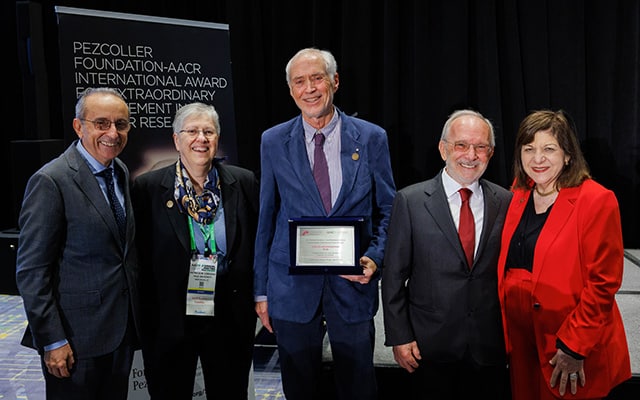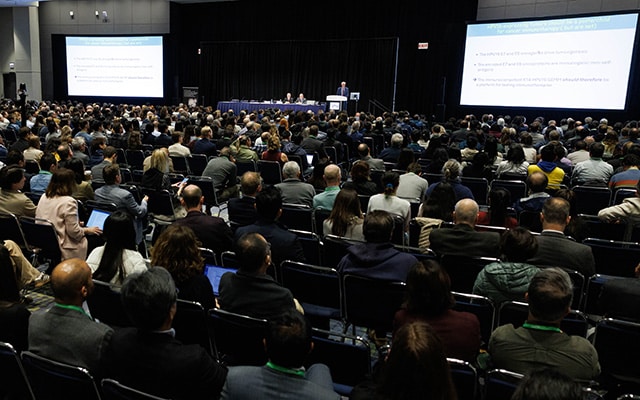Douglas Hanahan, PhD, FAACR—the recipient of the 2025 Pezcoller Foundation-AACR International Award for Extraordinary Achievement in Cancer Research—is no stranger to pivotal moments in oncology. And he thinks we may be on the brink of more breakthroughs against hard-to-treat tumors like uterine cervical cancer and glioblastoma, an aggressive form of brain cancer, thanks to his latest research on finding ways to overcome immunosuppression.
A quarter of a century ago, Hanahan published “The Hallmarks of Cancer,” a conceptual framework that gave researchers a common language for the traits that enable cancers to become malignant. In two subsequent updates, most recently in the AACR journal Cancer Discovery in 2022, he has expanded on the original foundation and incorporated the latest science to help move the field forward. (Read more about each iteration of the hallmarks of cancer in this past blog post.) Hanahan is currently the president emeritus of the Swiss Federal Institute of Technology and a distinguished scholar with the Ludwig Institute for Cancer Research in Lausanne, Switzerland.
In an effort to “move basic cancer biology toward cancer medicine,” Hanahan unveiled two lines of work in his lecture that dive deeper into one of the hallmarks of cancer first acknowledged in the 2011 update: avoiding immune destruction. Specifically, he revealed how tumors sabotage immune responses far beyond their own borders and how an old antidepressant might turn one of oncology’s most intractable cancers into an immunotherapy target.
Short-circuiting Systemic Immunosuppression
The centerpiece of his talk focused on human papillomavirus type 16 (HPV16)-driven cancers, especially cervical cancer. While cervical cancers that express HPV16-specific oncoproteins might seem like ideal candidates for vaccine therapy, Hanahan noted that therapeutic vaccines have often floundered in both mice and humans.
His group suspected the problem lay outside the tumor microenvironment and were a result of systemic immunosuppression. In a Cancer Discovery article published simultaneously during the conference, the team performed multiomic screens of cervical tumor tissue, as well as the bone marrow, spleen, and blood, to identify molecules and pathways that maintain systemic immunosuppression. Three cytokines from the interleukin-1 (IL-1) family leapt out as significant: IL-1alpha, IL-33, and IL-36beta. While these IL-1 family cytokines bind different receptors on the surface of cells, the downstream signaling of all three relies on the IL1RAP coreceptor component expressed mainly by developing neutrophils.

When the IL-1 family trio engages IL1RAP, bone marrow output skews toward neutrophils, spleens swell, and those neutrophils migrate to lymph nodes and tumors where they paralyze the T-cell response a vaccine needs to elicit tumor elimination. In the lab, T cells grown with splenocytes from tumor-bearing mice had significantly reduced proliferation, helping to explain why a vaccine alone is typically ineffective.
Fortunately, blocking IL1RAP can break the spell. A mouse antibody against IL1RAP reduced neutrophil counts, shrank spleens, and—paired with a nanoparticle vaccine targeting the E7 HPV oncoprotein—sparked T-cell infiltration and rapid tumor regression, and significantly improved survival. Somewhat surprisingly, CTLA-4 immunotherapy, but not PD-L1 immunotherapy, widened the survival gap further.
The clinical relevance of this approach looks promising, according to Hanahan, whose team mined data from The Cancer Genome Atlas (TCGA) to build a 10-gene systemic immunosuppression score that included IL-1alpha, IL-33, and IL-36beta, among other molecules. Tumors that scored high—whether cervical, head and neck, or lung cancer—were linked to poorer prognosis, hinting that IL-1-driven systemic immunosuppression may be a common escape route.
“We believe that a triplet of this HPV16 oncoprotein vaccine, anti-IL1RAP … plus anti-CTLA-4 warrants consideration for clinical trials,” Hanahan concluded.
Early data from a first-in-human trial provides some support, though PD-1 immunotherapy appeared beneficial in this clinical context. When nadunolimab, a humanized antibody against IL1RAP, was combined with PD-1 blockade, elevated neutrophil counts normalized in patients with lung and pancreatic cancers. This positions IL1RAP blockade as a practical path to disarm systemic immunosuppression and potentially enhance the effects of various immunotherapies, though the distinct effects of combinations involving different immune checkpoint inhibitors must be further clarified.

Antidepressant Flips Macrophages’ Mood Against Tumors
Hanahan next offered a glimpse into cancer neuro-immunology. His lecture’s closing act shifted to glioblastoma, where imipramine, a 60-year-old tricyclic antidepressant, emerged as an unlikely ally. In mouse glioblastoma models, the antidepressant turbocharged autophagy in tumor cells and flipped macrophages from a tumor-supporting to a tumor-attacking state.
Combined with VEGF blockade, the drug normalized aberrant blood vessels and cleared a path for adaptive immune cells to more efficiently enter tumors. Yet most mice eventually relapsed, until an anti-PD-L1 antibody was added to the mix. The triple therapy flooded tumors with T cells and doubled survival compared to the antidepressant plus VEGF inhibition. A Swiss pilot study, PHENIX, will soon test imipramine, the VEGF-A antibody bevacizumab (Avastin), and the anti-PD-1 antibody cemiplimab (Libtayo) in patients with recurrent glioblastoma.
Both stories extend Hanahan’s original hallmarks. Immune evasion is not just a skirmish at the tumor rim; it can be a body-wide blockade or a brain-tuned switchboard. But each defense reveals a seam: IL1RAP antibodies for HPV cancers, an antidepressant-anchored cocktail for glioblastoma. For a scientist whose frameworks have guided oncology for decades, the 2025 Pezcoller Foundation-AACR International Award lecture felt less like the closing of a chapter than the opening of a new front in the effort against cancer.



